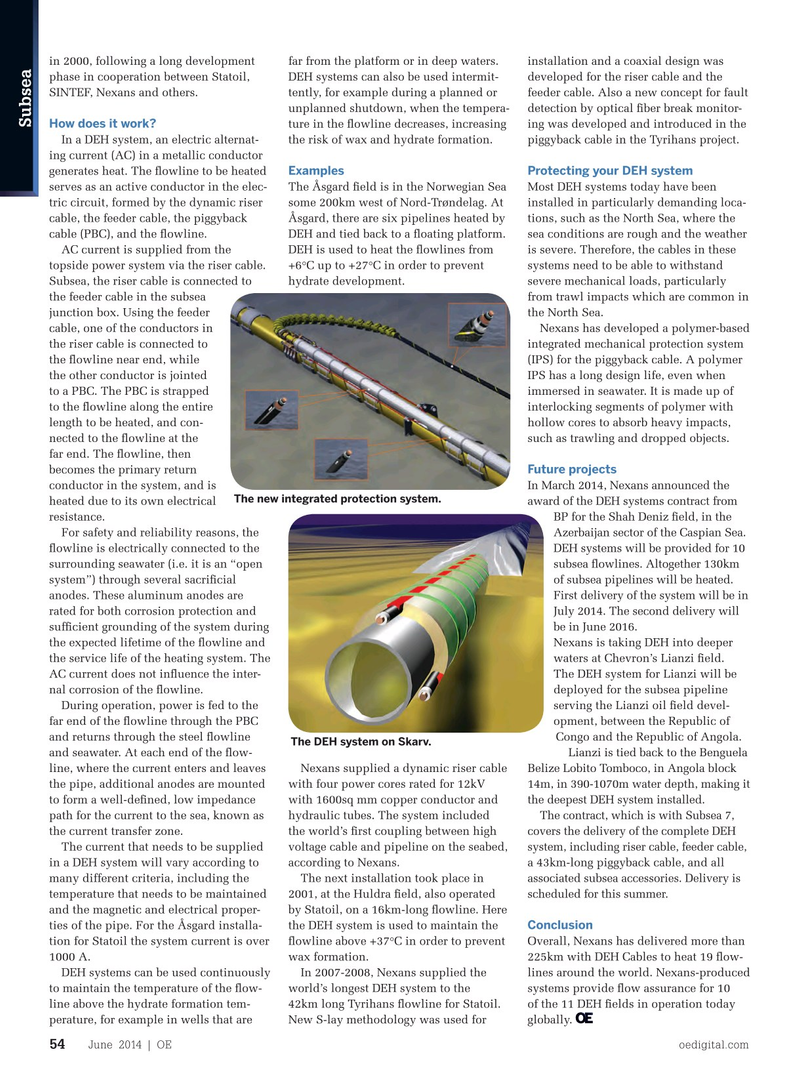
Page 52: of Offshore Engineer Magazine (Jun/Jul 2014)
Read this page in Pdf, Flash or Html5 edition of Jun/Jul 2014 Offshore Engineer Magazine
in 2000, following a long development far from the platform or in deep waters. installation and a coaxial design was phase in cooperation between Statoil, DEH systems can also be used intermit- developed for the riser cable and the
SINTEF, Nexans and others. tently, for example during a planned or feeder cable. Also a new concept for fault unplanned shutdown, when the tempera- detection by optical fber break monitor-
Subsea
How does it work? ture in the fowline decreases, increasing ing was developed and introduced in the
In a DEH system, an electric alternat- the risk of wax and hydrate formation. piggyback cable in the Tyrihans project.
ing current (AC) in a metallic conductor
Examples Protecting your DEH system generates heat. The fowline to be heated serves as an active conductor in the elec- The Åsgard feld is in the Norwegian Sea Most DEH systems today have been tric circuit, formed by the dynamic riser some 200km west of Nord-Trøndelag. At installed in particularly demanding loca- cable, the feeder cable, the piggyback Åsgard, there are six pipelines heated by tions, such as the North Sea, where the cable (PBC), and the fowline. DEH and tied back to a foating platform. sea conditions are rough and the weather
AC current is supplied from the DEH is used to heat the fowlines from is severe. Therefore, the cables in these topside power system via the riser cable. +6°C up to +27°C in order to prevent systems need to be able to withstand
Subsea, the riser cable is connected to hydrate development. severe mechanical loads, particularly the feeder cable in the subsea from trawl impacts which are common in junction box. Using the feeder the North Sea. cable, one of the conductors in Nexans has developed a polymer-based the riser cable is connected to integrated mechanical protection system the fowline near end, while (IPS) for the piggyback cable. A polymer the other conductor is jointed IPS has a long design life, even when to a PBC. The PBC is strapped immersed in seawater. It is made up of to the fowline along the entire interlocking segments of polymer with length to be heated, and con- hollow cores to absorb heavy impacts, nected to the fowline at the such as trawling and dropped objects.
far end. The fowline, then
Future projects becomes the primary return conductor in the system, and is In March 2014, Nexans announced the
The new integrated protection system. heated due to its own electrical award of the DEH systems contract from resistance. BP for the Shah Deniz feld, in the
For safety and reliability reasons, the Azerbaijan sector of the Caspian Sea. fowline is electrically connected to the DEH systems will be provided for 10 surrounding seawater (i.e. it is an “open subsea fowlines. Altogether 130km system”) through several sacrifcial of subsea pipelines will be heated. anodes. These aluminum anodes are First delivery of the system will be in rated for both corrosion protection and July 2014. The second delivery will suffcient grounding of the system during be in June 2016.
the expected lifetime of the fowline and Nexans is taking DEH into deeper the service life of the heating system. The waters at Chevron’s Lianzi feld.
AC current does not infuence the inter- The DEH system for Lianzi will be nal corrosion of the fowline. deployed for the subsea pipeline
During operation, power is fed to the serving the Lianzi oil feld devel- far end of the fowline through the PBC opment, between the Republic of and returns through the steel fowline Congo and the Republic of Angola.
The DEH system on Skarv.
and seawater. At each end of the fow- Lianzi is tied back to the Benguela line, where the current enters and leaves Nexans supplied a dynamic riser cable Belize Lobito Tomboco, in Angola block the pipe, additional anodes are mounted with four power cores rated for 12kV 14m, in 390-1070m water depth, making it to form a well-defned, low impedance with 1600sq mm copper conductor and the deepest DEH system installed.
The contract, which is with Subsea 7, path for the current to the sea, known as hydraulic tubes. The system included covers the delivery of the complete DEH the current transfer zone. the world’s frst coupling between high
The current that needs to be supplied system, including riser cable, feeder cable, voltage cable and pipeline on the seabed, in a DEH system will vary according to according to Nexans. a 43km-long piggyback cable, and all associated subsea accessories. Delivery is many different criteria, including the
The next installation took place in scheduled for this summer.
temperature that needs to be maintained 2001, at the Huldra feld, also operated and the magnetic and electrical proper- by Statoil, on a 16km-long fowline. Here
Conclusion ties of the pipe. For the Åsgard installa- the DEH system is used to maintain the tion for Statoil the system current is over fowline above +37°C in order to prevent Overall, Nexans has delivered more than 1000 A. wax formation. 225km with DEH Cables to heat 19 fow-
DEH systems can be used continuously In 2007-2008, Nexans supplied the lines around the world. Nexans-produced to maintain the temperature of the fow- world’s longest DEH system to the systems provide fow assurance for 10 line above the hydrate formation tem- 42km long Tyrihans fowline for Statoil. of the 11 DEH felds in operation today perature, for example in wells that are New S-lay methodology was used for globally.
June 2014 | OE oedigital.com 54 056_OE0614_Subsea3_Nexans.indd 54 5/22/14 10:24 PM

 51
51

 53
53